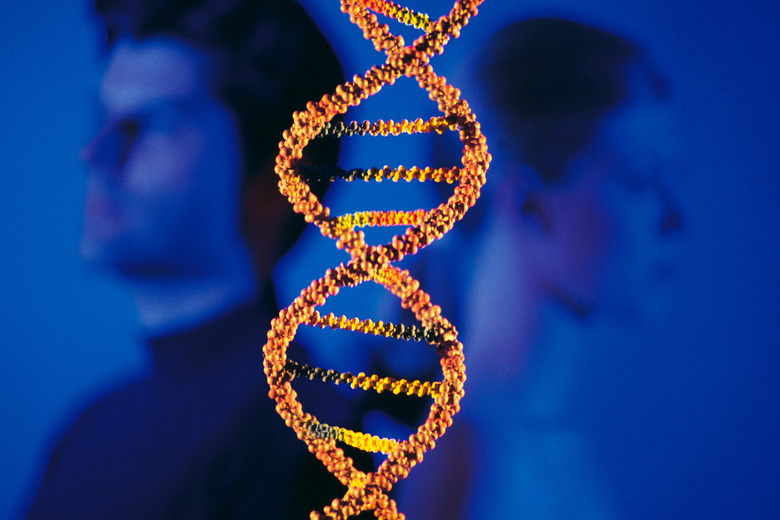How Much Time Does It Take For A DNA Molecule To Replicate?
Deoxyribonucleic acid, or DNA, is nature's molecule for transmitting genetic information across the generations. Most every cell in your body contains 46 chromosomes — a set of 23 from each parent — that the cell must replicate before it can divide.
Read more about the structure, function and important of DNA.
On the other hand, a bacterium (and other prokaryotes) usually has a single chromosome. Surprisingly, it takes about the same time, about an hour or less, for you and a bacterium to replicate DNA through the same DNA replication steps.
DNA Basics: Structure
DNA Basics: Structure
The timing of replication depends on the speed of DNA replication, the amount of DNA in the cell, and the number of replication origins on each DNA molecule. DNA is a long polymer with a backbone of alternating sugar and phosphate groups. One of four nitrogenous nucleotide bases hangs off each sugar group. The sequence of the bases is a four-letter alphabet that spells out the sequence of amino acids in proteins, the molecules that are responsible for your physical traits and biochemistry.
DNA Basics: Replication
DNA Basics: Replication
Chromosomes are compact packages of DNA and proteins. Two strands of DNA form a double helix at the heart of each chromosome.
Read more about what a chromosome is.
For replication to proceed, the cell's machinery must unzip the double helix and use each exposed strand as a template for building a new partner strand. This is semiconservative replication, in which the final product is two helices, each with an original strand and a new one. The base pairs in the template strand determine those in the new strand through a process of complementary pairing — each type of nucleotide base can only pair with a specific partner.
General Steps of DNA Replication
General Steps of DNA Replication
These are the DNA basics of DNA replication.
**Step 1: Replication Fork Forms.** An enzyme called DNA helicase "unzips" the double helix into a Y-forked formation.
**Step 2: Primers Bind.** DNA primers bind to the areas where the replication enzyme, DNA polymerase, will start replicating. The primers act as a signal to the enzyme and lets it know where to start and what direction to go in.
**Step 3: Elongation.** This is the phase where the DNA is actually replicated. The DNA polymerase "elongates" the new strand, meaning it starts making the new strand based off of each template strand.
**Step 4: Termination.** Once replication is complete, a couple of things happen. First, an enzyme called "exonuclease" takes the primers off the DNA and those spots are filled in with the proper DNA sequence.
Next, one strand (called the "lagging" strand") needs DNA ligase to connect the fragments of DNA that were just replicated. Another enzyme comes through to check and fix any errors made during replication. The last of the DNA replication steps is when telomerase adds special sequences called "telomeres" to the end of the strands.
Bacterial Replication
Bacterial Replication
The single chromosome of a bacterium is a loop of double-stranded DNA. The number of bases can vary from one species to another. The well-known bacteria E. coli has 4.7 million base pairs that take about 40 minutes to replicate, implying a speed of over 1,000 bases per second.
Replication starts at a single fixed location and proceeds on each strand in opposite directions. The replication process includes a proofreading step that ensures a mistake rate no higher than one in one billion.
Eukaryotic Replication
Eukaryotic Replication
The cells of humans and other eukaryotes have organized nuclei enclosing a set of chromosomes. The typical human chromosome has about 150 million base pairs that the cell replicates at the rate of 50 pairs per second. At that speed of DNA replication, it would take the cell over a month to copy a chromosome.
The fact that it takes only one hour is because of multiple replication origins. Replication simultaneously proceeds from many different points on the chromosome, and enzymes join the sections together to form the final intact copy. All 46 human chromosomes replicate at the same time, during the S phase of the cell cycle.
Cite This Article
MLA
Finance, Eric Bank, MBA, MS. "How Much Time Does It Take For A DNA Molecule To Replicate?" sciencing.com, https://www.sciencing.com/much-time-dna-molecule-replicate-21660/. 30 July 2019.
APA
Finance, Eric Bank, MBA, MS. (2019, July 30). How Much Time Does It Take For A DNA Molecule To Replicate?. sciencing.com. Retrieved from https://www.sciencing.com/much-time-dna-molecule-replicate-21660/
Chicago
Finance, Eric Bank, MBA, MS. How Much Time Does It Take For A DNA Molecule To Replicate? last modified August 30, 2022. https://www.sciencing.com/much-time-dna-molecule-replicate-21660/
